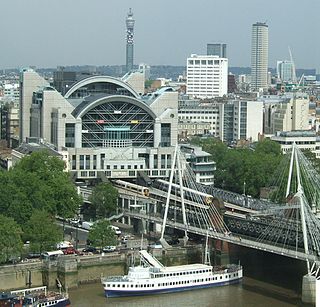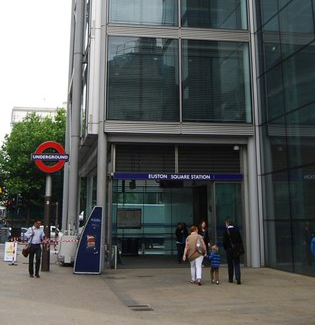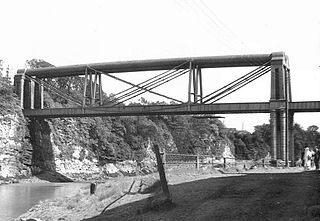
On 5 December 1905, the iron-and-glass overall arched roof of London Charing Cross railway station collapsed during a long-term maintenance project, killing six people.

On 5 December 1905, the iron-and-glass overall arched roof of London Charing Cross railway station collapsed during a long-term maintenance project, killing six people.
The roof was designed by Sir John Hawkshaw and comprised a single-span trussed arch with wrought iron tie rods. The roof was 164 feet (50 m) wide and 510 feet (160 m) long and was designed as a contained arch, with bowstring principals. [1]
At around 3:30 pm on 5 December 1905, one of the tie-rods of a main principal sheared, making a loud noise. [1] Some passengers evacuated the station, although many remained.
At about 3:42 pm, two complete roof bays (about 77 feet (23 m)) fell onto the platforms and rails, [1] and the western wall collapsed outwards on to the adjacent Royal Avenue Theatre (now the Playhouse Theatre), which was being reconstructed. [2] The glass 'wind-screen' at the river end was also brought down.
There were four trains in the station at the time on platforms 3 to 6 and the girders and debris from the roof fell across them. Many passengers had already boarded the trains, otherwise the total killed could have been greater. [1]
The apparent collapse of the roof was due to the structural failure of a flawed piece of ironwork. [3] The roof had also been heavily loaded with scaffolding and materials just before the final collapse.
Six people were killed, two of whom were working on the roof at the time. One fatality was an employee of W H Smith and the three remaining fatalities were workmen reconstructing the Royal Avenue Theatre which was crushed by the western side wall. [1] [4]
Eight other workmen were seriously injured and taken to hospital and nineteen others suffered minor injuries. [1]
The station was closed for over three months and during this period the Charing Cross Bridge was also examined and some girders added to reinforce it. [5] The Charing Cross, Euston and Hampstead Railway company – now part of the London Underground's Northern line – was able to take advantage of this closure when constructing its Charing Cross Underground station, making a large excavation in the main-line station's forecourt that would not have been allowed otherwise. The previous intention was to have excavated upwards from platform level. [6] [7]
The Charing Cross roof was replaced by a utilitarian post and girder structure supporting a ridge and furrow roof. [3] The curve of the original roof design can still be seen on the interior brickwork. The station was re-opened on 19 March 1906.
Because one undetected flaw caused such a large failure, questions were raised about the design and the safety factor against failure. A similar roof at Cannon Street station was taken down in 1958.[ citation needed ]

The Jubilee line is a London Underground line that runs between Stratford in east London and Stanmore in the suburban north-west, via the Docklands, South Bank and West End. Opened in 1979, it is the newest line on the Underground network, although some sections of track date back to 1932 and some stations to 1879.

The Northern line is a London Underground line that runs from North London to South London. It is printed in black on the Tube map. The Northern line is unique on the Underground network in having two different routes through central London, two southern branches and two northern branches. Despite its name, it does not serve the northernmost stations on the Underground, though it does serve the southernmost station at Morden, the terminus of one of the two southern branches.

Cannon Street station, also known as London Cannon Street, is a central London railway terminus and connected London Underground station in Travelcard zone 1 located on Cannon Street in the City of London and managed by Network Rail. It is one of two London termini of the South Eastern Main Line, the other being Charing Cross, while the Underground station is on the Circle and District lines, between Monument and Mansion House. The station runs services by Southeastern, mostly catering for commuters in southeast London and Kent, with occasional services further into the latter.

Charing Cross is a London Underground station at Charing Cross in the City of Westminster. The station is served by the Bakerloo and Northern lines and provides an interchange with Charing Cross mainline station. On the Bakerloo line it is between Embankment and Piccadilly Circus stations and on the Northern line it is between Embankment and Leicester Square stations. The station is in fare zone 1.

Embankment is a London Underground station in the City of Westminster, known by various names during its history. It is served by the Circle, District, Northern and Bakerloo lines. On the Bakerloo line and the Charing Cross branch of the Northern line, the station is between Waterloo and Charing Cross stations; on the Circle and District lines, it is between Westminster and Temple and is in Travelcard Zone 1. The station has two entrances, one on Victoria Embankment and the other on Villiers Street. The station is adjacent to Victoria Embankment Gardens and is close to Charing Cross station, Embankment Pier, Hungerford Bridge, Cleopatra's Needle, the Royal Air Force Memorial, the Savoy Chapel and Savoy Hotel and the Playhouse and New Players Theatres.

Charing Cross railway station is a central London railway terminus between the Strand and Hungerford Bridge in the City of Westminster. It is the terminus of the Southeastern Main Lines to Dover via Ashford and Hastings via Tunbridge Wells. All trains are operated by Southeastern, which provides the majority of commuter and regional services to south-east London and Kent. It is connected to Charing Cross Underground station and is near to Embankment Underground station and Embankment Pier.

Aldwych is a closed station on the London Underground, located in the City of Westminster in Central London. It was opened in 1907 with the name Strand, after the street on which it is located. It was the terminus of the short Piccadilly line branch from Holborn that was a relic of the merger of two railway schemes. The station building is close to the Strand's junction with Surrey Street, near Aldwych. During its lifetime, the branch was the subject of a number of unrealised extension proposals that would have seen the tunnels through the station extended southwards, usually to Waterloo.

St Pancras railway station, officially known since 2007 as London St Pancras International, is a central London railway terminus on Euston Road in the London Borough of Camden. It is the terminus for Eurostar services from Belgium, France and the Netherlands to London. It provides East Midlands Railway services to Leicester, Corby, Derby, Sheffield and Nottingham on the Midland Main Line, Southeastern high-speed trains to Kent via Ebbsfleet International and Ashford International, and Thameslink cross-London services to Bedford, Cambridge, Peterborough, Brighton, Horsham and Gatwick Airport. It stands between the British Library, the Regent's Canal and London King's Cross railway station, with which it shares a London Underground station, King's Cross St Pancras.

Euston is a London Underground station. It directly connects with Euston main line station above it. The station is in Travelcard Zone 1.

Kennington is a London Underground station on Kennington Park Road in Kennington within the London Borough of Southwark. The station is at the junction of the Charing Cross and Bank branches of the Northern line to the north and the Morden and Battersea Power Station branches to the south. Its neighbouring stations to the north are Waterloo on the Charing Cross branch and Elephant & Castle on the Bank branch; the next stations to the south are Oval and Nine Elms. The station is in both Travelcard Zones 1 and 2.

Euston Square is a London Underground station at the corner of Euston Road and Gower Street, just north of University College London – its main (south) entrance faces the tower of University College Hospital. The multi-interchange Euston station is beyond Euston Square Gardens, which is one street east. The station is between Great Portland Street and King's Cross St Pancras on the Circle, Hammersmith & City and Metropolitan lines in Travelcard Zone 1.

The Hungerford Bridge crosses the River Thames in London, and lies between Waterloo Bridge and Westminster Bridge. Owned by Network Rail Infrastructure Ltd it is a steel truss railway bridge flanked by two more recent, cable-stayed, pedestrian bridges that share the railway bridge's foundation piers, and which are named the Golden Jubilee Bridges.

Waterloo East railway station, also known as London Waterloo East, is a railway station in central London on the line from Charing Cross through to London Bridge towards Kent, in the south-east of England. It is to the east of London Waterloo railway station and close to Southwark tube station.

The Jubilee Line Extension (JLE) is the extension of the London Underground Jubilee line from Green Park to Stratford through south and east London. An eastward extension of the line was first proposed in the 1970s. As part of the development of London Docklands, the line was extended to serve Canary Wharf and other areas of south and east London. Construction began in 1993, and it opened in stages from May to December 1999, at a cost of £3.5 billion.

Tulse Hill railway station is in the Tulse Hill area of the London Borough of Lambeth in south London, between railway bridges over the A205, South Circular Road and the A215, Norwood Road. It is 5 miles 2 chains (8.1 km) measured from London Victoria. At the moment, there are 4 platforms, each long enough for 8 coaches.

The Charing Cross, Euston and Hampstead Railway (CCE&HR), also known as the Hampstead Tube, was a railway company established in 1891 that constructed a deep-level underground "tube" railway in London. Construction of the CCE&HR was delayed for more than a decade while funding was sought. In 1900 it became a subsidiary of the Underground Electric Railways Company of London (UERL), controlled by American financier Charles Yerkes. The UERL quickly raised the funds, mainly from foreign investors. Various routes were planned, but a number of these were rejected by Parliament. Plans for tunnels under Hampstead Heath were authorised, despite opposition by many local residents who believed they would damage the ecology of the Heath.

Chepstow Railway Bridge was built to the instructions of Isambard Kingdom Brunel in 1852. The "Great Tubular Bridge" over the River Wye at Chepstow, which at that point forms the boundary between Wales and England, is considered one of Brunel's major achievements, despite its appearance. It was economical in its use of materials, and would prove to be the design prototype for Brunel's Royal Albert Bridge at Saltash. Although the superstructure has since been replaced, Brunel's tubular iron supports are still in place. It is a Grade II listed structure.
The Norwood Junction railway crash occurred on 1 May 1891, when a cast-iron underbridge over Portland Road, 60 yards (55 m) north-east of Norwood Junction railway station, fractured under the weight of an express train from Brighton to London Bridge.
Old Ford was a railway station in Old Ford, north of Bow, in east London. The railway through the site was opened on 26 September 1850 by the East & West India Docks & Birmingham Junction Railway which was renamed in 1853 as the North London Railway (NLR), It was not until 1 July 1867 that Old Ford station opened. It was situated between Victoria Park and Bow, and was located on Old Ford Road, east of the junction with Lefevre Road.

The Waterloo and Whitehall Railway was a proposed and partly constructed 19th century Rammell pneumatic railway in central London intended to run under the River Thames just upstream from Hungerford Bridge, running from Waterloo station to the Whitehall end of Great Scotland Yard. The later Baker Street and Waterloo Railway followed a similar alignment for part of its route.